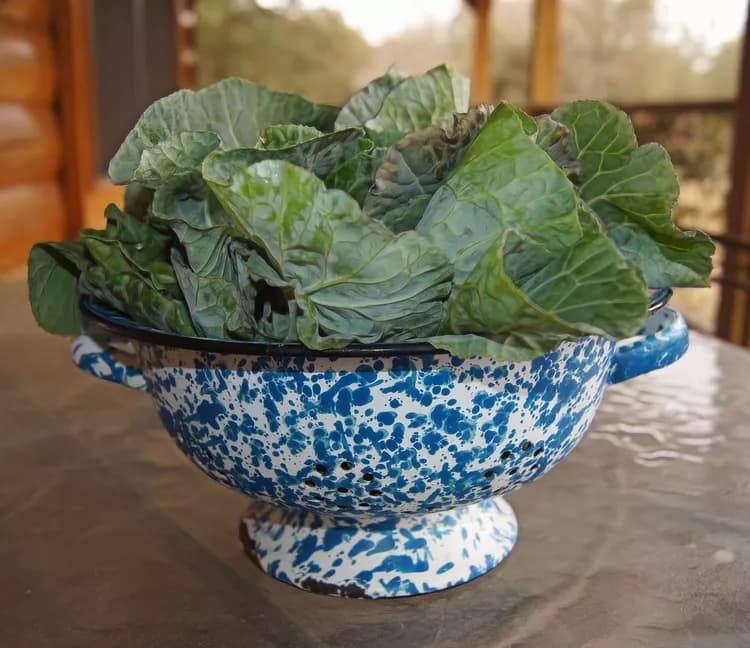Collard greens are large, dark-colored, leaves used for food and as an ornamental plant. They are grown mainly in Brazil, Portugal, the southern United States, Montenegro, Bosnia and Herzegovina, southern Croatia, northern Spain and in India. The plant is available year round; however, collard greens are more nutritious and more desirable during the cold months, after the first frost.
Here are seven health benefits of collard greens.
1. Collard greens are superb for improving bone health.
One cup of collard greens contains 836 mcg or 1,045 percent of vitamin K. Vitamin K enhances calcium absorption, reduces urinary excretion of calcium, and acts as a modifier of bone matrix proteins. Also, one cup of collard greens contains 27 percent of your calcium needs, which can help reduce the risk of osteoporosis and other bone-related diseases.
2. Collard greens can help individuals with type 2 diabetes.
One cup of collard greens contains 5.3 grams of dietary fiber. It is recommended by the Dietary Guidelines for Americans that 25 grams and 38 grams of fiber should be consumed for women and men, respectively. High-fiber diets have been known to lower blood glucose levels. Also, collard greens contain an antioxidant known as alpha-lipoic acid, which has been shown to reduce glucose levels, increase insulin sensitivity, and prevent oxidative stress-induced damage in individuals with type 2 diabetes.
3. Collard greens can help improve digestion.
High-fiber foods like collard greens have been known to prevent constipation, promote regularity, possibly prevent certain colon diseases like irritable bowel syndrome, diverticulitis, fecal impaction, ulcerative colitis, Crohn’s disease, and leaky gut syndrome.
Research, published in Food & Function, suggests the absence of the plant enzyme myrosinase like in cooked broccoli but also found in collard greens could help protect the health of our stomach lining by preventing bacterial overgrowth and the clinging of bacteria to our stomach wall.
4. Collard greens can help promote healthy looking skin and hair.
Collard greens can assist the skin and hair quality with the high vitamin A, vitamin C, and iron content. Vitamin A is required for sebum production that keeps hair moisturized and for the growth of all bodily tissues, including skin and hair. Vitamin C helps your body produce and maintain collagen, an essential structural protein in your skin and hair. Adequate iron intake could help prevent hair loss since iron deficiency is a common cause of hair loss.
5. Collard greens can contribute to improving sleep and overall mood.
The choline in collard greens is an essential nutrient that helps with sleep, muscle movement, learning, and memory. Collard greens are also a great source of folate. Folate may help treat depression by preventing an excess of homocysteine from forming in the body. Excess homocysteine disrupts the production of the feel-good hormones serotonin, dopamine, and norepinephrine, which regulate not only mood but also sleep and appetite as well.
6. Collard greens can help fight cancer.
High intake of cruciferous vegetables, like collard greens, has consistently been associated with a lower risk of developing colorectal, lung, and prostate cancer. New studies have shown that glucosinolates, a sulfur-containing compound found in collard greens, may be effective against melanoma, esophageal cancer, and pancreatic cancer. They become biologically active when they are converted to indoles, thiocyanates, and isothiocyanates through chewing or the digestive process. This natural killing compound has been known to reduce inflammation, neutralize cancer-killing chemicals, and prevent the formation and metastasis tumors.
7. Collard greens can help improve immune response.
Researchers from the University of California at Berkeley have recently discovered that a compound called 3,3'-diindolylmethane in collard greens is a powerful modulator of the natural immune response system with potent antiviral, antibacterial, and anticancer activity.
Related Articles
Test Your Knowledge
Asked by users
Related Centers
Related Specialties
Related Physicians
Related Procedures
Related Resources
Join DoveHubs
and connect with fellow professionals


0 Comments
Please log in to post a comment.